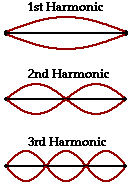
We'll look a string of length L fixed at both ends (ie. Guitar strings).
Nodes, places on the wave with zero displacement, are present at each end of the string, where it is attatched. Strings have a number of natural patterns of oscillation, called Normal Modes. Each of these have their own natural frequency, depending on where the string is held down.
These normal modes of vibration form a series of 'harmonics'.

If we think of an open guitar string, being held down to the head and the fret board (at the node points), we look at the diagram of the 1st harmonic. Here, the length of the wave is twice the length of the string. This is known as the fundamental frequency. The anti node is right in the center of the string. The frequencies of these normal modes form a harmonic series. That means, when we distort a guitar string, (pluck, strum), the resulting vibration includes various harmonics, all at once. The normal modes are called harmonics. We can demonstrate a harmonic on the guitar.